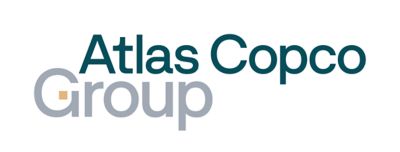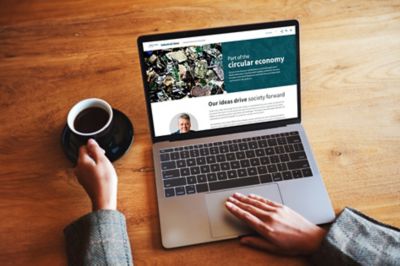ATLAS COPCO Interim report on the six months ended June 30, 1999 (unaudited)
August 12, 1999
Improvements in the second quarter
The Atlas Copco Group's revenues for the first six months of 1999 decreased 2 percent, to SEK 16,370 m. (16,784) corresponding to a volume decrease of 5 percent. Orders received were unchanged at SEK 16,900 m. (16,913). Foreign exchange fluctuations had a positive translation effect of 3 percentage points. The Atlas Copco Group's profit after financial items decreased, to SEK 1,425 m. (1,824). The profit margin was 8.7 percent (10.9). The second quarter accounted for SEK 868 m of the profit, representing a margin of 10.1 percent. Outlook European economies are likely to fulfill current expectations of more robust growth. This should gradually improve demand in the region. Demand in North America is expected to develop positively, primarily driven by the continuing trend in the U.S. towards outsourcing for equipment, which benefits the rental service business. In South America, the generally poor business conditions are expected to continue, mainly as a result of still high interest rates and relatively low mining activity. For the Asian region, the recent growth is expected to continue in South Korea and some smaller markets, while demand in other countries is expected to be flat at best. In summary, overall customer demand is expected to improve somewhat in the near term mainly as a result of growth in the equipment rental industry in the U.S. Market development Demand in Europe was mixed in the first half of the year. The strongest development was seen in southern Europe, especially Spain, while demand in Great Britain and the Nordic countries remained weak. The situation in France and to some extent Germany, the two biggest markets in the region, improved in the second quarter. In North America, construction activity remained healthy. Demand for investment goods for the manufacturing and process industry showed signs of improvement in the second quarter from the low levels of previous quarters. Demand was very low in Latin America during the period, particularly in the beginning of the year. However, lower interest rates and a stable currency in Brazil helped to slow deterioration of demand in the second quarter. The higher oil price level started to improve demand in some African and Middle East countries, while most other markets in those regions remained weak. In Asia, only South Korea recorded any substantial improvement in economic activity. Demand in India, China, and Japan stayed relatively weak. Sales development Orders received were marginally less than the first half of 1998, at SEK 16,900 m. (16,913), including a positive currency effect of 3 percentage points. Sales volumes in January and February were considerably lower than in the same period the previous year but recovered by the end of the period. The sales development of the four business areas compared to the previous year was mixed, varying from an increase to a substantial decrease. Sales prices were unchanged on average. Revenues decreased 2 percent, to SEK 16,370 m. (16,784), corresponding to a volume drop of 5 percent. Earnings Operating profit decreased SEK 368 m., to SEK 1,787 m. (2,155), or 17 percent from the first half of 1998. The negative effect on profit from the volume decrease and the unfavorable mix in the overall composition of sales was more than SEK 400 m., while changes in exchange rates had a marginal positive effect. The adjustments and smaller structural changes to adapt to a lower level of activity, primarily in the first part of the year, started to show results in the second quarter. Operating margins dropped, to 10.9 percent (12.8). Net financial items amounted to SEK -362 m. (-331), of which net interest items accounted for SEK -355 m. (-327). Net interest from exchange rate hedging on foreign net assets was negative, at SEK -10 m. (1). Since the majority of the Group's loans is denominated in U.S. dollars, the higher USD/SEK exchange rate also had a negative effect on net interest. Profit after financial items decreased 22 percent, to SEK 1,425 m. (1,824). The profit margin was 8.7 percent (10.9). Net profit for the period totaled SEK 935 m. (1,164), or SEK 5.09 per share (6.34). The return on capital employed during the 12 months to June 30, 1999, was 15 percent (19), and the return on shareholders' equity 14 percent (17). Second quarter The Atlas Copco Group's revenues for the second quarter of 1999 decreased 1 percent, to SEK 8,619 m., from SEK 8,676 m. in 1998. Changes in exchange rates produced an increase of 4 percentage points, while volumes resulted in a decrease of 5 percentage points. Operating profit decreased 4 percent, to SEK 1,062 m. (1,112), corresponding to a margin of 12.3 percent (12.8). Profit after financial items declined 8 percent, to SEK 868 m. (943), and net profit for the second quarter totaled SEK 577 m. (603), corresponding to SEK 3.14 per share (3.28). Changes in exchange rates had a small positive effect. Orders received amounted to SEK 8,744 m. (8,509); a 1-percent loss in volumes was offset by positive exchange rate effects of 4 percent. Cash flow and net indebtedness The operating cash surplus after tax for the first six months of 1999 reached SEK 1,796 m. (1,717), equal to 11 percent (10) of Group revenues. Working capital decreased SEK 169 m. (increased 502) during the period, positively affecting cash flow from operations, which increased to SEK 1,965 m. (1,215). Investment in tangible fixed assets was SEK 1,089 m. (1,043). Dividends were paid in the second quarter and amounted to SEK 829 m. (780). Net cash flow equaled SEK 317 m. (-386). The Group's net indebtedness (defined as the difference between interest-bearing liabilities and liquid assets) amounted to SEK 10,327m. (10,666), of which SEK 1,414 m. (2,041) was attributable to pension provisions. The decline in pension provisions reflected the creation in the first quarter of 1999 of a pension trust in Sweden that is not consolidated in the Group's accounts. Liquid assets were simultaneously reduced by the same amount, SEK 522 m., so there was no effect on reported net indebtedness. The debt/equity ratio (defined as net indebtedness divided by shareholders' equity) was 66 percent (76). Liquid assets at the end of the period totaled SEK 1,463 m. (1,915). Including minority interests, the Atlas Copco Group's shareholders' equity totaled SEK 15,553 m. (13,984), or SEK 85 per share (76). The equity/assets ratio was 42 percent (39). Investments Investments in property and machinery totaled SEK 378 m. (338). Investments in rental equipment reached SEK 711 m. (705). During the period, total depreciation on these two asset groups was SEK 761 m. (693). Distribution of shares Share capital amounted to SEK 918 m. at the end of the period, distributed as follows. See also the comments under Equity right issue. Personnel At June 30, 1999, the number of employees was 22,428 (23,712). For comparable units, the number of employees decreased by 900 in the first half of 1999. Year 2000 readiness In March 1996, Atlas Copco initiated a Group-wide survey of computer systems in use. Every site reported on the present status of its systems and its action plans to handle the year-2000 issue for those systems that were not judged year-2000 compliant. Year-2000 follow-up is on the agenda of the Business Board at each division and site, and status reports are mandatory items at Board Meetings. All costs for modifications to comply with the year 2000 are charged as operational costs. Group Management believes that, based on the Group-wide survey that is continously updated, and actions already taken, the remaining costs to the Group to become year-2000 compliant will not have a material effect on the Group's financial position or the results of operations. Management further believes that remaining modifications and conversions to new systems are very limited and in line with plans. However, the operations of Atlas Copco's computer systems are vulnerable to third parties', principally suppliers', possible failure to remedy their own year-2000 issues. To the extent that systems by third parties on which Atlas Copco's systems rely are not converted in time, there can be no assurance that such third parties' non-compliance would not have a material effect upon the Group's systems. Structural changes affecting the reporting period On January 1, 1999, Rental Service became the fourth business area, and Prime Service its only division. Prime Service constituted a separate division in the Compressor Technique business area throughout 1998. Effective January 1, 1999, Rand-Air Ltd., South Africa, was acquired by Atlas Copco. Rand-Air is a compressor rental company. The company has about 200 employees and annual sales of roughly SEK 90 m. and is part of the Portable Air division. Effective November 1998, Atlas Copco acquired JKS Boyles, a Canadian manufacturer of exploration drilling rigs. The company has 79 employees and annual sales of about SEK 115 m. JKS Boyles is part of the Atlas Copco Craelius division. Effective October 1, 1998, Atlas Copco combined the operations of its U.S. subsidiaries Atlas Copco Rental, Inc., and Prime Service, Inc., to better meet the needs of industrial companies for rental equipment. During 1998, the Prime Service division acquired three equipment rental companies in the U.S. and Mexico, with aggregate annual revenues of roughly SEK 340 m. Subsequent events Effective July 29, Atlas Copco acquired Rental Service Corporation, a company publicly traded on the New York Stock Exchange. Rental Service Corporation had revenues in the last reported twelve month period of approximately SEK 5,520 m. and an operating margin of 17 percent. Total consideration included approximately SEK 5,990 m. cash paid for all shares in the company and SEK 7,790 m. of assumed debt. The acquisition is expected to have a positive impact on earnings for the first full year. Synergies are expected to be approximately SEK 160 m. in the first full calendar year and to increase as the business grows. Rental Service Corporation has 3,600 employees, operates more than 270 equipment rental locations in 29 states, and has a base of more than 50,000 customers. Rental Service Corporation and Prime Service Inc. are now the two divisions constituting the Rental Service business area. Effective July 1, 1999, ABIRD Holding BV, the Netherlands, was acquired by Atlas Copco. ABIRD is a specialty rental company. The company has 25 employees and had annual sales of about SEK 40 m. in 1998. ABIRD is part of the Atlas Copco Portable Air division. Equity rights issue To strengthen the Group's capital base and enhance financial flexibility following the acquisition of Rental Service Corporation, the Board of Directors' have decided to launch an issue of new shares with preferential rights to existing shareholders, subject to any restrictions that may be imposed by applicable local laws outside of Sweden. The new shares will be issued at a subscription price of SEK 160 per share at a ratio of 1:7 and will provide the company with proceeds of approximately SEK 4,190 million. The decision is subject to the approval of the Extraordinary General Meeting, which is scheduled to be held on September 6, 1999. Business areas Starting in 1999, orders and revenues reported by business area also include intercompany sales to other business areas. Figures for 1998 have been adjusted accordingly. Compressor Technique The Compressor Technique business area consists of five divisions in the following product areas: Industrial compressors, Portable compressors, and Gas and process compressors. Orders received during the period declined 4 percent, to SEK 6,604 m. (6,868), down 6 percent by volume. However, in the second quarter volumes were on a par with those of the same quarter in 1998. Sales in Europe continued to be mixed, with strong trends in the Alpine region and southern Europe and weak demand in northern Europe. Orders in North America were down for the six-month period, primarily because of weak demand from the energy sector. A significant sales drop was recorded in Brazil and most other Latin American markets, particularly due to the very low activity in the first quarter. In Asia, sales in South Korea improved from a low level, while most other markets remained weak or declined. Sales of small industrial compressors were stable at a good level, while the previous negative trend in demand for large investment-related industrial compressors flattened out in the second quarter. Portable compressors continued to enjoy healthy demand from the equipment rental industry, while other segments declined. The rental industry was also the main reason behind strong sales development of heavy-duty generators. Revenues decreased 7 percent, to SEK 6,393 m. (6,844). The problems in the first quarter related to the new logistics system, that negatively affected invoicing of mainly spare parts, were solved in the second quarter. Operating profit fell 20 percent, to SEK 962 m. (1,202), resulting in an operating margin of 15.0 percent (17.6). The profit and margin weakened as a result of lower volumes and changes in the product and market mix. Construction and Mining Technique The Construction and Mining Technique business area consists of five divisions in the following product areas: Drilling rigs, Rock drilling tools, Construction tools, and Loading equipment. Orders received during the period were SEK 3,027 m. (3,365), down 10 percent in total and 9 percent in volume. Activity in the mining industry stayed low, affecting primarily sales of drill rigs and loaders. The lack of new big construction projects in Asia further reduced sales to this region. Good orders for drilling rigs from the construction sector in Europe, primarily Germany, and North America partly compensated for the overall weak market conditions for the business area. Revenues ended at SEK 2,830 m. (3,295), down 14 percent in total and 12 percent in volume. Operating profit decreased SEK 71 m., to SEK 188 m., corresponding to a margin of 6.6 percent (7.9). The effect of substantially lower volumes was partly offset by efficiency gains. Industrial Technique The Industrial Technique business area consists of four divisions in the following product areas: Electric and pneumatic power tools, Assembly systems, and Motion control products. Orders received during the period increased 6 percent, to SEK 5,274 m. (4,991), including a positive currency effect of 4 percent. The level of orders from the automotive industry in Western Europe and North America was favorable, while demand from automakers in Brazil was very weak. In the United States, sales of electric power tools remained strong, while sales of industrial tools to general manufacturing decreased. Orders for electric power tools in Europe showed healthy improvement in the second quarter. With few exceptions, Asian markets were weak. Revenues increased 3 percent, to SEK 5,093m. (4,955), on volumes relatively unchanged from one year previous. Operating profit decreased 10 percent, to SEK 473 m. (524), as a result of unfavorable changes in the product mix and the unsatisfactory development of sales and costs for parts of the industrial tools business. The profit resulted in a margin of 9.3 percent (10.6). Rental Service The Rental Service business area consists of one division in the equipment rental industry, providing services to the construction and industrial markets. Revenues during the period rose 24 percent, to SEK 2,284 m. (1,847). Growth for comparable units was 5 percent when adjusted for currency effects. Demand from the energy sector was weak, as were revenues from oil-free compressor rental for industrial applications. The important non-residential building sector remained active and generated increased revenues. Operating profit, which includes all related goodwill amortization, was SEK 229 m. (220), corresponding to an operating margin of 10.0 percent (11.9). The weaker margin resulted from a lower fleet utilization rate than in the first half of 1998. The margin was particularly weak in the first quarter but recovered to 12.1 percent in the second quarter. Stockholm, August 12, 1999 Giulio Mazzalupi President and Chief Executive Officer The interim report on the Atlas Copco Group's operations for the nine-month period January to September 1999 will be published on October 26, 1999. For further information, please contact Annika Berglund, Vice President, Corporate Communications (media), phone +46 8 743 8070, mobile +46 70 322 8070, [email protected] Hans Ola Meyer, Senior Vice President, Group Treasurer (analysts), phone +46 8 743 8292, mobile +46 70 588 8292,[email protected] Overhead presentations from Atlas Copco For your convenience, an overhead presentation of Atlas Copco's half-year 1999 results will be published on Atlas Copco's Internet site. Please go to www.atlascopco.com > Investor Relations > Presentations > Investor Presentations. More information is available at www.atlascopco.com Atlas Copco Group Income Statement *) Starting in 1999, revenues reported by business area also include intercompany sales to other business areas. Figures for 1998 have been adjusted accordingly. Earnings by Business Area





